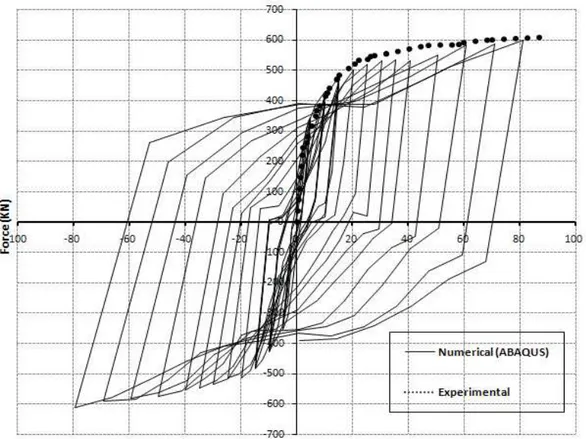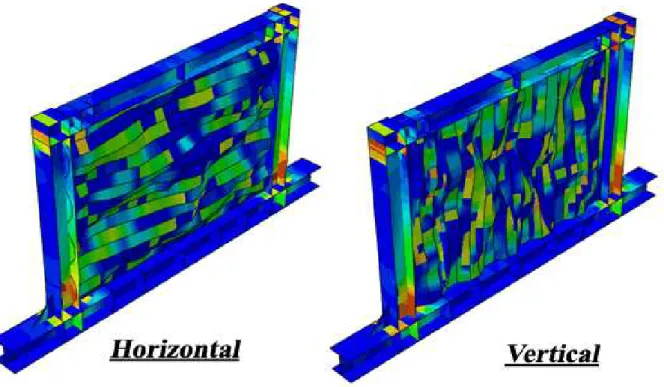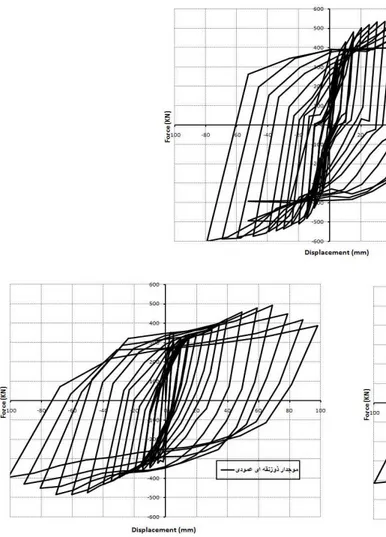Vol-7, Special Issue-Number4-June, 2016, pp608-614 http://www.bipublication.com
Case Report
Numerical Investigation of the Seismic Behavior of Corrugated Steel Shear
Wall by ABAQUS software
*Ali Banazadeh and Ahmad Maleki
Civil Engineering- Seism,
Islamic Azad University,
Maragheh Branch, Maragheh, Iran.
*alibanazadeh1362@yahoo.com.
ABSTRACT
Advantages of using steel shear walls in supplying the requirements of regulations relating to the peripheral loadings including winds and earthquake have caused that the use develops in constructs. High capacity of the system inenergy dissipation, significant primary stiffness, and profitability are among main advantages of this system. However, it has some weaknesses such as elastic buckling of the filler plate before its flow which this issue sometimes causes the increase in the need to out-of-plate stiffness of columns. One of the methods of coping with this phenomenon is the use ofcorrugated plates instead ofbed plates. Different studies indicate that this group of plates enjoy relatively better capacity of absorbing energy and reduce in-plate instability of the system as well. The present study is to investigate and model numerically this type of plate using ABAQUS software and by gauging the verification of numerical model outputs, develop the use of it on plates with different angular position. The results indicate that in spite of the reduction in theultimate bearing capacity of corrugated plates compared to bed plates, the degree of absorbing energy and formability of the system increases significantly.
Keywords: Maximum of corrugated steel plate shear wall, buckling, energy absorption, formability, cyclic loading.
1. INTRODUCTION
Steel Structures are expansively used in constructing buildings in seismically active areas due to their high resistance and formability. Lateral resistant systems in steel structures are usually designed as flexural resistant frames and braced frames. Each of these systems have their own strengths and weaknesses. For example, usually formability of flexural frames is higher than that of braced frames, and stiffness of braced frames are usually higher than flexural frames. However, costs of constructing braced frames are higher.
A steel plate shear wall is another option as a lateral resistant system appropriate for new constructs and a reinforcing system for existing construct. This system is comprised of steel plates
addition, it has high stiffness and capacity of energy absorption, but its construction costs are high [2].
One of the suggestions has been presented for coping with the above weakness is the use of steel plate shear wall with corrugated plates. Making a plate corrugated causes the increase in out-of-plate stiffness and resistance of plate shear buckling and consequently, results in the deletion of stiffeners. With regard to the issue that little research has been conducted on this idea and little information about characteristics and regulations of design is available for steel plate shear wall withcorrugated plates. Therefore, such a research is necessary for realizing this needs. Therefore, in the present study, by modeling the behavior of steel shear walls by ABAQUS software and its verification, the results obtained from modeling corrugated steel shear walls are used. The results obtained from these studies will illustrate clearly the effect of corrugated steel plates on the behavior of steel plate shear wall under seismic loading.
2. Review of literature
In 2013, Vigh et al. [3] used the FEMA p-695 for
assessing seismic response parameters of
buildings with steel frames with a corrugated steel plate shear wall for the seismic resistant system as indicated in figure 1. They indicated in the research that the acceptance criteria for the seismic response in this method for this system is as four.
Figure 1 Layout of shear walls and experimental settings
Khazaei et al. (2011) [4] conducted a research titled as “investigating seismic behavior of the hybrid system of steel shear walls with corrugated plates and flexural frames”. The aim of the research was to investigate numerically the seismic behavior of steel shear walls with corrugated plates and assess how shear force is divided between plates and frames surrounding them. To do so, models firstly were analyzing by the linear buckling analysis in order that their final loadings before buckling can be obtained. Then, nonlinear behavior analyses after their buckling were studied. The result of their study obtained from comparing the behavior of corrugated steel shear walls and simple steel shear walls (figure 2)
indicates higher formability and behavior
coefficient as well as more energy loss.
Figure 2 comparing formability of corrugated plates and simple plates [4]
3. Modelling and verification of the model of finite elements of steel plate shear walls
Figure 3 geometry and location of the steel shear wall, unit in terms of mm [5] Table 1 features of used materials [5]
Because ABAQUS software has a realistic stimulation of theshear walls under seismic loading, for each cycle on which increase in the load occurs, a separate step is defined. Therefore, regarding figure 4 indicating the sequence of loading in the control-displacement based on the AC154 [6], defining 12 steps is required for this issue. In figure 4, the AED axes indicates the values of approximate elastic displacement as 20 mm.
Figure 4 sequence of loading in control-displacement form
Figure 5 comparing deformation of experimental and numerical models
Data of the shear-deformation curve of the above figure is transmitted to the numerical analysis of the Excel software and compared with the sheath of the shear-deformation curve of the experimental sample as indicated in figure 6. As indicated in the figure, the basic shear-displacement obtained from the numerical analysis has relatively higher shear force and displacement than the experimental model. This is due to idealization of materials and interaction between connected components and also loading conditions. In numerical models, by cyclic loading, overlap of curves is acceptable and supplies the accuracy of numerical modeling.
Figure 6comparingbasic shear-displacement of experimental and numerical models
Therefore, regarding the accuracy of motioned stimulation, in the next section, the modelled steel shear wall with trapezoidal corrugated plates, in same loading conditions and different loading conditions, was evaluated and the results obtained from different conditions were reported.
Totally, two samples of corrugated steel shear walls were analyzed and model by ABAQUS software; one has one horizontal and one vertical trapezoidal corrugated steel plate. Both models have materials according to table 1, and loadings are put according to figure 4. Both samples are in semi-scale, single-floor, and single-aperture forms. In these models, surrounding beams and columns and boundary conditions are similar to those of the model in the previous section. In figure 7, geometrical features of trapezoidal corrugated plates are shown.
Figure 7 geometrical features of trapezoidal corrugated plates, unit in terms of mm
In figure 8, the stress contour of both samples at the end of loading and after resistance reduction is indicated. In the corrugated steel plate shear wall system in figure 8, less parts of beams and columns have reached the plastic stress, but in the simple steel plate shear wall in figure 5, a large part of beams and columns have reached plastic stress. Therefore, energy absorption of the corrugated steel plate shear wall is higher and consequently,the corrugated steel plate shear wall with higher absorption of seismic force prevents more force transmission to beams and columns.
Figure 8 the maximum stress contour of the trapezoidal corrugated steel plate shear wall at the end of loadings
Figure 9 Hysteretic behaviour of the analysed samples
Formability and amount of absorbed energy under the seismic load are important parameters in the resistant systems of lateral loads. As indicated in figure 9, although all instances absorb energy with stable hysteretic rings, in the simple sample, the amount of absorbed energy is less and its final load is higher than the two corrugated samples so that in the simple sample, the final load is equal 60 KN in the vertical corrugated sample and 49 KN I the horizontal one.
5. CONCLUSION
Verifying the numerical and experimental results indicated that ABAQUS software can model most of behavioral features and the mode of breakage of simple and corrugated shear walls in frames of
a floor under the seismic load in such a way that the corrugated steel plate tolerates high out-of-plate stiffness and high elastic shear resistance. Furthermore, with appropriate design, the vertical corrugated steel plate is able to absorb a lot of seismic energy via plastic formability so that the total energy absorbed by the corrugated sample is equal as 1.52 times higher than that of the simple one.
6. REFERENCES
1. Driver RG, Kulak GL, Kennedy DJL, Elwi
AE. (1998), “Cyclic test of four-story steel plate shear wall”, J StructEng ASCE; 124(2):112–20.
2. Takahashi Y, Takemoto Y, Takeda T, Takagi
M. (1973), “Experimental study on thin steel shear walls and particular bracings under alternative horizontal load”, Preliminary rep. IABSE symp. On resistance and ultimate deformability of struct. Acted on by
well-defined reported loads. International
Association for Bridge and Structural
Engineering, Lisbon, Portugal; pp. 185–191.
3. Vigh LG, Deierlein GG, MirandaE, LielAB,
Tipping S. (2013), “Seismic performance assessment of steel corrugated shear wall system using non-linear analysis”, J Constr Steel Res2013; 85:48–59.
4. KhazaeiRavari, M. and Ebrahimi, H. (2011).
“Investigating seismic behavior of the hybrid system of steel shear walls with corrugated plates and Flexural frames”. The Sixth National Congress of Civil Engineering, Semnan, Semnan University, Iran, 6 and 7 May.
5. Emami, F., Mofid, M. and Vafai, A., (2013),
“Experimental study on cyclic behavior of trapezoidally corrugated steel shear walls”, Journal of Engineering Structures, 48, 750-762.
6. AC 154. (2008), “Acceptance criteria for cyclic
![Figure 2 comparing formability of corrugated plates and simple plates [4]](https://thumb-eu.123doks.com/thumbv2/123dok_br/18129937.325210/2.892.105.424.812.1045/figure-comparing-formability-corrugated-plates-simple-plates.webp)
![Figure 3 geometry and location of the steel shear wall, unit in terms of mm [5]](https://thumb-eu.123doks.com/thumbv2/123dok_br/18129937.325210/3.892.124.770.157.522/figure-geometry-location-steel-shear-wall-unit-terms.webp)


